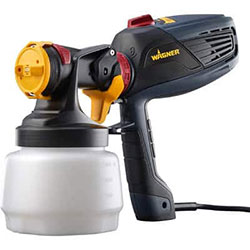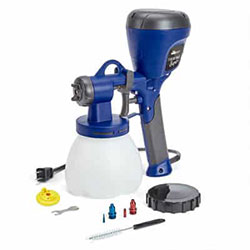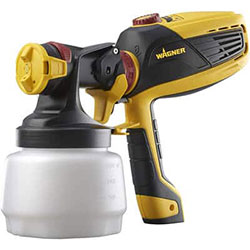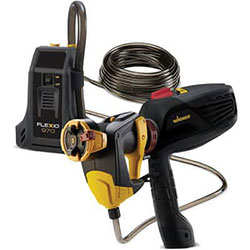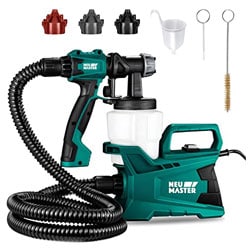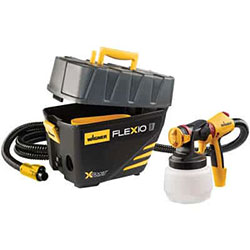The Best Turbine Paint Sprayer — Buyers Guide, Review and Comparison
Top Turbine Products from Each Category
| IMAGE | PRODUCT | DETAILS | ||
|---|---|---|---|---|
|
Best Handheld Turbine Sprayer 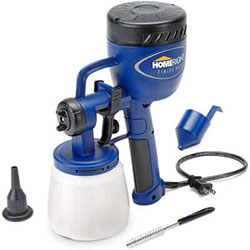
|
Best Handheld Turbine Sprayer
|
HomeRight Finish Max
|
Features
|
Check Price at Amazon Check Price at PSE HomeRight Finish Max Review HomeRight Finish Max Review |
|
Best External Turbine Sprayer 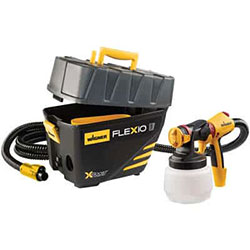
|
Best External Turbine Sprayer
|
Wagner FLEXiO 5000
|
Features
|
Check Price at Amazon Check Price at PSE Wagner FLEXiO 5000 Review Wagner FLEXiO 5000 Review |
|
Best Professional Turbine Sprayer 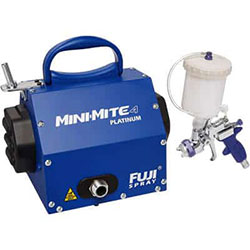
|
Best Professional Turbine Sprayer
|
Fuji Mini-Mite 4
|
Features
|
Check Price at Amazon Check Price at PSE Fuji Mini-Mite 4 Review Fuji Mini-Mite 4 Review |
|
Best Budget Turbine Sprayer 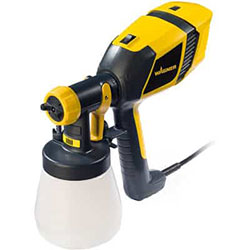
|
Best Budget Turbine Sprayer
|
Wagner Control Spray 250
|
Features
|
Check Price at Amazon Check Price at PSE Control Spray 250 Review Control Spray 250 Review |
Turbine Paint Sprayer Reviews and Buying Guide
Typically lighter on the pocket than a pneumatic machine and more straightforward to operate than an airless unit — the turbine paint sprayer is the ideal DIY and trade machine.
Featuring models ranging from lightweight handheld tools through to heavy-duty externally powered examples — the turbine category covers a range of applications including furniture restoration, crafting, home redecoration, and automotive respraying.
What Are Turbine Paint Sprayers?
Where a pneumatic sprayer uses compressed air to propel the paint, and an airless machine utilizes a hydraulic piston, a turbine unit uses, well, a turbine.
Generally speaking, a turbine is nothing more than a fan, or series of fans, which in the case of sprayers, pushes the paint out of the gun nozzle.
An electric motor turns the vanes of an internal fan, driving air into the paint cup through the inlet tube. The increased pressure within the container then propels the paint upwards through a fluid pickup hose and into the tip — where it is atomized and proceeds to cover your base material.
Depending on the model, these extremely versatile machines are suited to large applications, such as wall spraying and fence staining, as well as less substantial jobs like cabinet finishing and furniture staining. Perhaps the only niche in which they’re less than ideal is automotive respraying.
Admittedly, there are some car-focused turbine sprayers, for example, the Wagner MotoCoat. But, while excellent for trim work and small touch-ups — they lack the perfectly smooth finish required for a motor top coat. If that’s your area of interest, I suggest checking out the best pneumatic sprayers instead — which offer the ultimate in atomization and a perfect sheen.
What Are Turbine Stages?
While for the uninitiated, this at first may be an area of bewilderment, in reality, it’s not. These ‘stages’ simply refer to the number of fans within the machine. Hence, a single-stage turbine has one fan, a three-stage machine has three fans, and, you’ve got it, a four-stage has four fans.
And, more fans means more power.
The greater the number of stages, the higher the internal pressure — meaning that it can deliver more viscous paints, such as latex, without placing undue pressure on the motor. Furthermore, this elevated grunt permits the machine to drive dense liquids through smaller tips — leading to greater atomization and therefore, a finer finish.
Standard home-use machines have one or two stages, high-end DIY units three or four, and professional-grade machines four or more.
So, in theory, opting for the greatest number of stages will give you the most powerful and versatile machine — although, bear in mind that the more fans your sprayer has, usually the higher the price point.
That said, you don’t always need the mother-of-all turbine units with enough fan-grunt to power a small country. If the majority of your applications include utilizing thin mediums such as stains, sealers, and lacquers — for example upcycling furniture or finishing cabinet work — a single or two-stage machine will be sufficient.
What Is an HVLP Turbine Spray System?
While HVLP (high-volume low-pressure) turbine machines have existed since the 1930s (basically, vacuum cleaners running in reverse) they didn’t achieve any kind of serious market penetration until the 1990s.
Before this heady decade when Richard Gere was curb-crawling in Pretty Woman and REM were losing their religion, paint spraying was virtually the sole domain of the professional. With the process requiring a seriously powerful (and expensive) gas-compressor — most homeowners had neither the funds nor space for an industrial-grade pneumatic unit.
Then, HVLP turbine spray guns rocked the power painting world.
Where traditional pneumatic machines required 70-90 PSI capacity compressors, these HVLP turbine sprayers could run at just 10 PSI or less — using a high-volume of air to propel the paint instead of huge pressure — hence HVLP.
This low-pressure requirement meant that no longer did homeowners require a mammoth compressor — instead, the gun could run off an electrically powered turbine, or a small consumer pneumatic unit.
The benefits of an HVLP turbine paint sprayer is that due to the lower force output — there’s less bounce-back and overspray. This means they’re ideally suited to DIY projects — as you’re less likely to cover your entire floor and walls with paint when all you want to do is recoat a coffee table. And, they reduce wastage, saving hard-earned dollars.
Are All Turbine Sprayers HVLP?
Yes. Even the mighty external turbine Apollo 5 with its five-stages only knocks out 10 PSI. The very nature of fan-powered spraying means air volume is high, but the pressure is low.
However, while all turbines are HVLP — not all HVLP’s are turbines.
You can purchase HVLP spray guns, such as the Accuspray 3m Turbine Spray Systems, which run off standard air compressors. These innovative shooters utilize a series of internal baffles to reduce the incoming high-pressure to a lower force, while increasing the volume delivery.
Types of HVLP Spray Gun Turbine Machines
Handheld HVLP Turbine Spray Gun
A handheld machine incorporates the gun, paint container, and turbine into one unit — typically appearing like an oversized hairdryer. Because of size and weight constraints, it’s unusual to find a 3 stage hvlp turbine paint sprayer in handheld format — usually, they’re single or two-stage.
Naturally, this means many of these machines are unsuitable for dense paints such as latex, milk, and chalk — they’re most commonly used in finishing projects. That said, some machines include a turbo paint sprayer function — such as the X-Boost in the FLEXiO 3000. This cranks up the power output, allowing the unit to deliver more viscous mediums.
Additionally, some models, like the Wagner 570, include a wide-diameter nozzle — in this case a proprietary 2.5 mm iSpray head — that permits the use of thick paints. While these oversized tips are ideal for rapid coverage of walls and fencing with dense mediums — atomization is low, meaning a roller-like finish rather than a perfectly smooth coat.
Depending on the specific machine, handheld turbine sprayers can boast features such as adjustable turbine control, a choice of spray patterns, and a selection of nozzle tips.
External Turbine HVLP Spray Gun
An external HVLP turbine sprayer is the go-to machine for larger, more substantial projects — such as complete indoor or outdoor home painting, fence weatherproofing, and decking staining.
Unlike handheld sprayers, these units have their turbine motor housed in a floor-standing case — meaning all you need to wield in your palm is the gun with an attached paint cup. This means that the weight of the shooter is drastically reduced, making it much more comfortable to use on expansive, time-heavy jobs.
Furthermore, this separate housing allows manufacturers to include more stages in their models than in handheld versions — as the tool isn’t restricted by weight constraints. This increased power output enables machines such as the DIY-centric FLEXiO 5000 and the pro-grade Fuji Mini-Mite to cope easily with viscous paints concomitant to substantial projects.
That said, external HVLP turbine spray guns aren’t all about mammoth jobs.
Some manufacturers retail units designed for finishing work — like the Control Spray. Typically, these machines come with a choice of tips, making them both suited to large coverage and light, precise coating. While the detailed application of thin stains and sealers may not require the immense power offered by external turbines — their lightweight and easy-to-wield guns allow for more accurate coverage.
Furthermore, there are some small indoor external turbine sprayers targeting the crafting, modeling, and hobbyist market. These power painters, such as the Wagner Home Decor, incorporate an external turbine no larger than those offered by a handheld unit — but offer the benefits of greater maneuverability and fatigue-free gun manipulation, factors crucial for accurate artwork.
How to Choose the Best HVLP Turbine Spray System
Here are factors I believe you should think about when picking the best turbine HVLP sprayer.

Handheld or External Turbine HVLP Sprayer
That said, for users who lack arm strength, suffer fatigue easily, or don’t possess the steady-hand of their younger years — the lightweight gun offered by external turbine units can be a welcome bonus, even on small-scale work.

DIY, Professional, or Budget
While all my turbine spray gun reviews below include only the best examples of powered sprayers — there is undoubtedly a difference in grades.
Budget machines offer an easy and affordable entry into the paint spraying world. Suitable for casual and infrequent use, these units would suit the home-user who anticipates no more than a few painting projects per year.
While the final coat finish will be satisfactory for most applications — they may lack the finesse for fine and precise work. That said, the pocket-friendly Rexbeti 750 comes complete with nozzles for both viscous paint coverage and thin medium detail projects.
DIY sprayers can be extremely basic — with few features — or verge on the semi-pro level, such as the Earlex HV5500. Typically more durable than their budget counterparts, they’re usually sufficiently robust to cope with monthly use.
Professional units are the pinnacle of turbine spraying. These machines can withstand hardcore use and abuse — their durability measured in gallons per week throughput. Targeting the tradesperson, they have the capability to be used on a daily basis.
Furthermore, these contractor-level sprayers offer greater tailorability and access to spare and upgradeable parts than their DIY cousins — but that does come with a significant price tag.
Hose/Cord Length
Length may not be everything — but it’s a crucial consideration when choosing the best HVLP turbine machine.
Handhelds don’t have a hose (as the turbine is incorporated into the gun), just a cord. The industry standard is six feet — which is usually sufficient for maneuvering around a piece of furniture. However, if you’re completing a more substantial project — such as waterproofing decking — it may be inadequate, requiring the use of extension leads. Hence, if your home projects are often sizeable — it may be worth considering a unit with a longer mains cord.
External turbines have both a cord and a hose — which makes them more suited to larger-scale jobs. This permits you to crack on with your spraying, without having to frequently relocate the sometimes heavy floor-sitting turbine. The Precision 5, for example, incorporates a mammoth 32-foot hose in addition to its power cable — making it excellent for expansive work.
That said, bear in mind that for both handheld and external machines — too much hose/cord length can be problematic, akin to handling an angry snake.
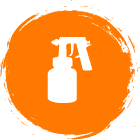
Paint Container
All turbine sprayers have an incorporated paint cup (well, except for the somewhat strange direct-draw Wagner 970) — delivering your coating medium via the pickup tube into the nozzle.
Undoubtedly, the primary consideration is size — the larger the container, the less requirement to refill on large jobs. However, that comes at a weight cost, making the unit tough on the arms when wielding for long periods.
In addition to its capacity, other paint cup considerations include:
- Material — acrylic cups are lightweight and affordable, yet are more difficult to clean and less durable than their more expensive metal counterparts.
- Internal coating — some units, such as the HV5500, have an internal non-stick PTFE (Teflon) layer, meaning less paint wastage and effortless post-project rinsing.
- Filling ease — the Tacklife SGP15AC incorporates a quick-refill lid, allowing you to replenish the container without removal from the paint gun.
Furthermore, many machines, like the Wagner 4000, come complete with a choice of cups — a low capacity version for small, intricate work and a more substantial container for larger projects.
Variable Turbine Power
The most basic, single-stage turbine sprayers, for example, the Control Spray 250, have just one power output setting — acceptable if you’re spraying thin viscosity mediums and you don’t require an ultra-fine finish.
However, for more discerning users, a variable-powered turbine is invaluable.
This feature allows you to adjust the grunt to suit your coating medium — toning it down for less dense paints and cranking it up for more viscous liquids. This prevents soaking your base material with too much thin stains and sealers, and permits you to propel dense fluids. Plus, the more turbine stages the machines possess — the greater its efficiency and delivery of thick paints.
Some DIY machines, such as the FLEXiO 590, have ten settings, while the pro-grade Precision 5 has an eye-watering 100 levels — adjustable in 0.1 PSI increments.
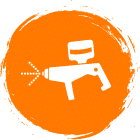
Nozzle
The nozzle dictates the covering mediums your turbine machine can deliver and the type of finish it provides.
Typically, manufacturers describe their tips in millimeters — relating to the diameter of the nozzle head. As a general rule, 1.6 mm or smaller is suitable for less dense mediums such as stains and sealers, while a size greater than 1.6 mm will suit viscous fluids — acrylics, latex, and chalk-based paints.
Hence, consider the liquids you will be using in your projects, to ensure the nozzle has the capacity to propel the medium adequately.
But then, things can become a little more complicated.
Many high-end DIY units and most pro-grade machines will feature a relatively small diameter nozzle — yet are capable of delivering dense paints. This is because they have a high-powered turbine, capable of propelling the thick liquid through a narrow tip.
The advantage of this is that it creates a higher level of atomization, providing a smooth and stipple-free finish. An excellent example of this is the Fuji Semi-Pro 2 — that while having a relatively small 1.3 mm nozzle, is ideal for viscous paints due to the high 1400-watt output of its turbine.
Additional Considerations
Other factors that are worthy of consideration when selecting your ideal turbine sprayer include:
- Choice of spray patterns — allowing you to address your base material in the most appropriate manner.
- Spray width adjustment — narrow for fine work, wide for larger projects.
- Warranty length — providing reassuring peace of mind.
- Additional accessories — such as extra needles, filling funnels, viscosity cups, and a carrying case.
Handheld Turbine Sprayers Comparison Table
| IMAGE | PRODUCT | DETAILS | |
|---|---|---|---|

|
HomeRight Finish Max
|
Features
|
Check Price at Amazon Check Price at PSE HomeRight Finish Max Review HomeRight Finish Max Review |
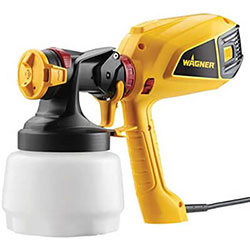 |
Wagner Control Painter
|
Features
|
Check Price at Amazon Wagner Control Painter Review Wagner Control Painter Review |
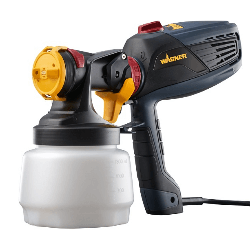 |
Wagner FLEXiO 2000
|
Features
|
Check Price at Amazon Check Price at PSE Wagner FLEXiO 2000 Review Wagner FLEXiO 2000 Review |
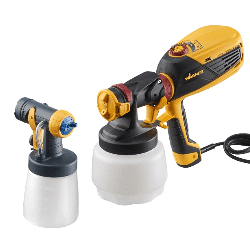 |
Wagner FLEXiO 3000
|
Features
|
Check Price at Amazon Wagner FLEXiO 3000 Review Wagner FLEXiO 3000 Review |
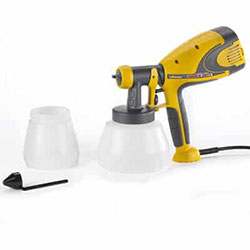 |
Wagner Control Spray Double Duty
|
Features
|
Check Price at Amazon Check Price at PSE Control Spray Double Duty Review Control Spray Double Duty Review |
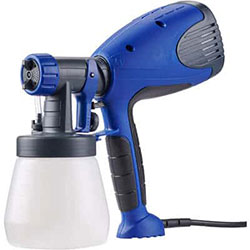 |
HomeRight Quick Finish
|
Features
|
Check Price at Amazon HomeRight Quick Finish Review HomeRight Quick Finish Review |
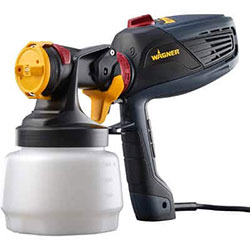 |
Wagner FLEXiO 570
|
Features
|
Check Price at Amazon Check Price at PSEWagner FLEXiO 570 Review Wagner FLEXiO 570 Review |
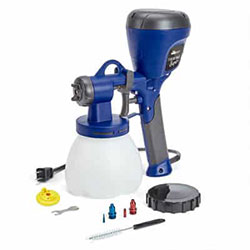 |
HomeRight SuperFinish Max
|
Features
|
Check Price at Amazon Super Finish Max Review Super Finish Max Review |
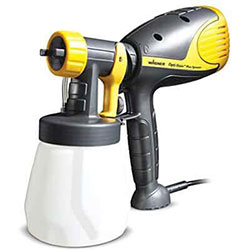 |
Wagner Opti Stain Plus
|
Features
|
Check Price at Amazon Opti Stain Plus Review Opti Stain Plus Review |
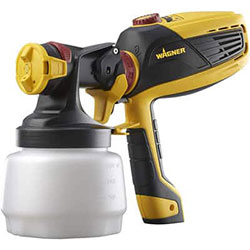 |
Wagner FLEXiO 590
|
Features
|
Check Price at Amazon Wagner FLEXiO 590 Review Wagner FLEXiO 590 Review |
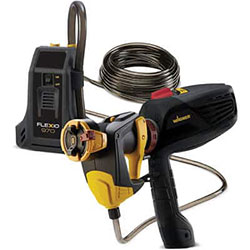 |
Wagner FLEXiO 970
|
Features
|
Check Price at Amazon Wagner FLEXiO 970 Review Wagner FLEXiO 970 Review |
Our Picks of the Best Handheld Turbine Sprayers
Suited to both powered-painting virgins and trade users — these tools are ideal for small-to-medium jobs such as upcycling furniture, varnishing cabinets, and staining shelving — together with some light fence and wall work.
With much more rapid coverage than a brush and providing smoother coats than a handheld roller — they reduce time-costs and workload while delivering a pleasing final finish.
HomeRight Finish Max
Pros
- 400-watt turbine.
- Brass spray tip.
- Variable control dial.
- Three spray patterns.
- Substantial handle.
- Design
- Functionality
- Price
Wagner Control Painter
Features
- Six-foot power cord.
- Lock-N-Go system enables rapid cleaning.
- Compatible with sealers through to acrylic paints.
- Container with 25 square feet coverage capacity.
- Interchangeable filter.
- Design
- Functionality
- Price
Wagner FLEXiO 2000
Features
- Dual speed.
- Three spray patterns.
- Intense black aesthetic.
- Width selector.
- Adjustable medium volume control.
- Design
- Functionality
- Price
Wagner FLEXiO 3000
Features
- Three spray patterns.
- Adjustable width control.
- Includes hard carry case and detail nozzle.
- Adjustable flow control.
- 1.5-quart container.
- Positive feedback in online HVLP turbine spray gun reviews.
- Design
- Functionality
- Price
Wagner Control Spray Double Duty
Features
- Delivers 4.9 fluid ounces per minute.
- Complete with 1/1.5-quart cups.
- Fatigue-busting handle.
- Mains lead protector.
- Replaceable filter.
- Design
- Functionality
- Price
HomeRight Quick Finish
Features
- Affordable unit for the casual DIYer.
- Three spray pattern options.
- Power lead protector.
- Replaceable filter.
- Backed by the mighty Wagner parent company.
- Design
- Functionality
- Price
Wagner FLEXiO 570
Features
- Two turbine speeds.
- Bold black design.
- Includes two containers and nozzles.
- 20 percent lighter than standard handheld machines.
- Ergonomic handle for fatigue-free use.
- Design
- Functionality
- Price
HomeRight SuperFinish Max
Features
- Durable brass spray tips.
- 100-square feet coverage capacity.
- Easy disassembly.
- Low overspray.
- Quiet operation.
- Design
- Functionality
- Price
Wagner Opti Stain Plus
Features
- Tailorable spray delivery.
- Six-foot cable.
- Twelve air-ventilation slots.
- Ideal for woodworking.
- Robust ABS construction.
- Design
- Functionality
- Price
Wagner FLEXiO 590
Features
- Industry-leading iSpray nozzle.
- Detail tip for fine finishing.
- Adjustable turbine power.
- Complete with a hard carry case.
- Suited to thin and viscous mediums.
- Design
- Functionality
- Price
Wagner FLEXiO 970
Features
- Unique pump and turbine combo.
- Delivers 8.8 gallons per hour.
- Dual-speed turbine.
- Effortless cleaning.
- Compatible with unthinned latex paints.
- Design
- Functionality
- Price
External Turbine Sprayers Comparison Table
| IMAGE | PRODUCT | DETAILS | |
|---|---|---|---|
 |
Wagner FLEXiO 5000
|
Features
|
Check Price at AmazonCheck Price at PSE Wagner FLEXiO 5000 Review Wagner FLEXiO 5000 Review |
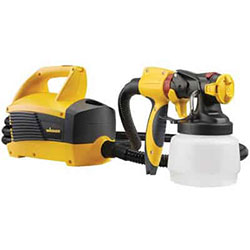 |
Wagner FLEXiO 4000
|
Features
|
Check Price at Amazon Check Price at PSE Wagner FLEXiO 4000 Review Wagner FLEXiO 4000 Review |
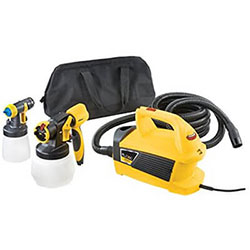 |
Wagner FLEXiO 690
|
Features
|
Check Price at Amazon Wagner FLEXiO 690 Review Wagner FLEXiO 690 Review |
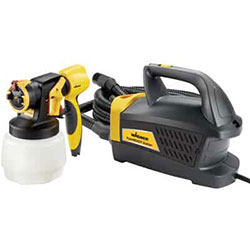 |
Wagner PaintReady
|
Features
|
Check Price at Amazon Wagner PaintReady Review Wagner PaintReady Review |
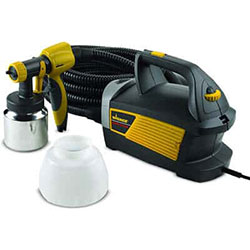 |
Wagner Spraytech Control Spray Max
|
Features
|
Check Price at Amazon Check Price at PSE Spraytech Control Spray Max Review Spraytech Control Spray Max Review |
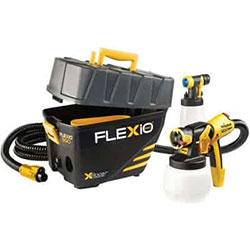 |
Wagner FLEXiO 890
|
Features
|
Check Price at Amazon Wagner FLEXiO 890 Review Wagner FLEXiO 890 Review |
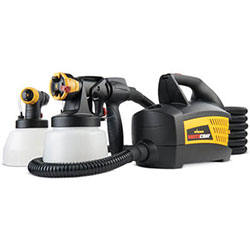 |
Wagner MotoCoat
|
Features
|
Check Price at Amazon Check Price at PSE Wagner MotoCoat Review Wagner MotoCoat Review |
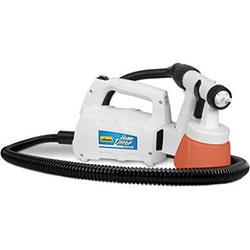 |
Wagner Home Decor
|
Features
|
Check Price at Amazon Check Price at PSE Wagner Home Decor Review Wagner Home Decor Review |
Our Picks of the Best External Turbine Spray Machines
With the power unit sitting in a floor-standing casing, the spray gun is relatively effortless to wield. And typically featuring adjustable turbine output levels, you can tailor the intensity of delivery to suit both your coating medium and base material.
Wagner FLEXiO 5000
Pros
- Upgraded iSpray nozzle.
- Variable material flow control.
- Easy to clean with the Lock-N-Go feature.
- User tailorable spray-width.
- Includes 1.5 and 0.85-quart cups.
- Design
- Functionality
- Price
Wagner FLEXiO 4000
Features
- 1.5-quart and 0.85-quart cups.
- Three spray patterns.
- Adjustable width control.
- 11x faster than a brush.
- Suitable for indoor and outdoor work.
- Twin nozzles.
- Design
- Functionality
- Price
Wagner FLEXiO 690
Features
- Three psi output.
- Twin nozzle heads and cups.
- Lock-N-Go design for straightforward disassembly.
- 15-foot hose.
- Respected manufacturer.
- Ideal for large DIY jobs.
- Design
- Functionality
- Price
Wagner PaintReady
Features
- 15-foot hose.
- A carrying handle promotes portability.
- Easy-to-clean casing.
- iSpray nozzle head for a flaw-free finish.
- Compatible with unthinned mediums.
- Design
- Functionality
- Price
Wagner Spraytech Control Spray Max
Features
- Straightforward operation.
- Blemish-free finish.
- One and 1.5-quart cups.
- Varnish compatible.
- Lightweight for an external turbine.
- Design
- Functionality
- Price
Wagner FLEXiO 890
Features
- Compatible with unthinned mediums.
- Spray-width control.
- Knocks out 8.4 gallons per hour.
- Choice of three spray patterns.
- 11.5-foot hose.
- Design
- Functionality
- Price
Wagner Motocoat
Features
- X-Boost turbine for fine atomization.
- Two paint containers, one for each nozzle.
- 39-foot flexible hose.
- Adjustable air pressure, spray width and paint flow.
- Lightweight and portable.
- User-friendly.
- Design
- Functionality
- Price
Wagner Home Decor
Features
- Specifically targets the crafting market.
- Compact for easy storage.
- Carrying handle.
- Material volume control.
- Durable construction.
- Design
- Functionality
- Price
Professional Turbine Sprayers Comparison Table
| IMAGE | PRODUCT | DETAILS | |
|---|---|---|---|
 |
Fuji Mini-Mite 4
|
Features
|
Check Price at Amazon Check Price at PSE Fuji Mini-Mite 4 Review Fuji Mini-Mite 4 Review |
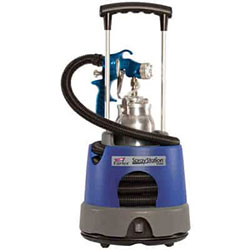 |
Earlex HV5500 HVLP Spray Station
|
Features
|
Check Price at Amazon Check Price at PSE Earlex HV5500 Review Earlex HV5500 Review |
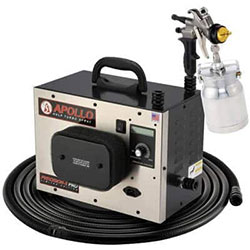 |
Apollo Precision 5 Pro LE
|
Features
|
Check Price at Amazon Check Price at PSE Apollo Precision 5 Pro Review Apollo Precision 5 Pro Review |
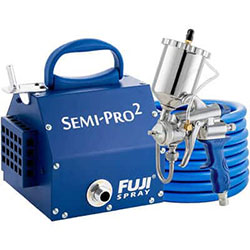 |
Fuji 2203G Semi-Pro Gravity System
|
Features
|
Check Price at Amazon Check Price at PSE Fuji 2203G Review Fuji 2203G Review |
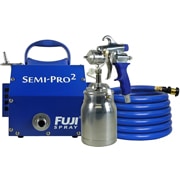 |
Fuji 2202 Semi-PRO 2 HVLP Spray System
|
Features
|
Check Price at Amazon Check Price at PSE Fuji 2202 Review Fuji 2202 Review |
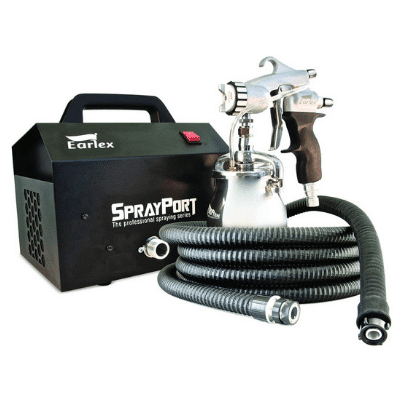
|
Earlex 0HV6003PUS Spray Port 6003
|
Features
|
Check Price at Amazon Check Price at PSE Earlex 0HV6003PUS Review Earlex 0HV6003PUS Review |
Our Picks of the Best Professional Turbine Paint Gun Machines
With customizable hydraulic pressure, these units deliver less overspray, wastage, and bounce-back than both turbines and pneumatic machines. Furthermore, with a controllable pump, they’re as suited to propelling thin stains and sealers as they are dense latex and chalk-based paints.
Admittedly, they’re not for the fainthearted. These are substantially sized sprayers that require a little practice to master. However, with Wagner’s Sureflo easy-priming system and many units being cart-mounted — they’re still suitable for the home DIYer.
Check out my Wagner airless paint sprayer reviews below:
Fuji Mini-Mite 4
Pros
- Four-stage turbine.
- Variable flow control.
- 25-foot hose.
- Affordable pro-level machine.
- 1.3mm spray tip.
- Design
- Functionality
- Price
Features
- Two-stage turbine.
- Robust construction.
- Incorporated carrying-handle.
- Teflon-coated metal gun and cup.
- 650 watts.
- Design
- Functionality
- Price
Apollo Precision 5 Pro LE
Features
- Gravity-fed system.
- Hopper capacity of 1.5 gallons.
- Horizontal or vertical 10-inch spray pattern.
- 25-foot hose.
- Integrated handles and tip storage.
- Design
- Functionality
- Price
Fuji 2203G Semi-Pro Gravity System
Features
- One-quart paint cup.
- 6.6 gallons per hour flow.
- EZ-Tilt feature.
- Paint/Stain adjustment switch.
- Suitable for medium-sized projects.
- Proprietary Optimus Spray Tip.
- Design
- Functionality
- Price
Fuji 2202 Semi-PRO 2 HVLP Spray System
Features
- Latex-compatible.
- 25-foot hose.
- Low overspray.
- Quick-connect feature.
- Lightweight for a metal turbine.
- Design
- Functionality
- Price
Earlex 0HV6003PUS Spray Port 6003
Features
- 1200-watt motor.
- 0.12 GPM flow rate.
- Air cap rotates through 360 degrees for multi-angle painting.
- Die-cast aluminum spray gun with low overspray.
- 25-foot Hyperflex hose.
- Design
- Functionality
- Price
Budget Turbine Sprayers Comparison Table
| IMAGE | PRODUCT | DETAILS | |
|---|---|---|---|
 |
Wagner Control Spray 250
|
Features
|
Check Price at Amazon Check Price at PSE Control Spray 250 Review Control Spray 250 Review |
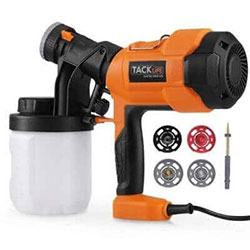
|
Tacklife SGP15AC
|
Features
|
Tacklife SGP15AC Review Tacklife SGP15AC Review |
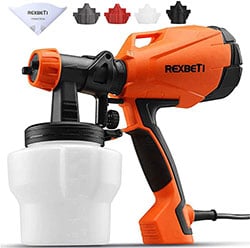 |
Rexbeti Ultimate 750
|
Features
|
Check Price at Amazon Rexbeti Ultimate 750 Review Rexbeti Ultimate 750 Review |
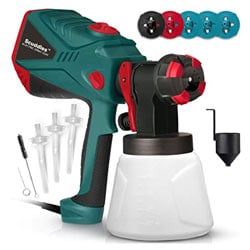 |
Scuddles Paint Sprayer
|
Features
|
Check Price at Amazon Scuddles Paint Sprayer Review Scuddles Paint Sprayer Review |
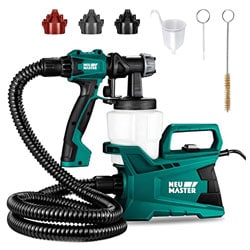 |
NEU MASTER N3140
|
Features
|
Check Price at Amazon NEU Master N3140 Review NEU Master N3140 Review |
Our Picks of the Best Budget Turbine Spray Gun Units
Budget turbine sprayers are suitable for the casual, intermittent, or newbie powered-paint user. These machines make for ideal home improvement tools — for small projects such as door coating, outdoor furniture staining, and shelf varnishing.
While not as powerful as the high-end DIY or pro-units, nor delivering such a fine-finish — many of these basic tools still include impressive features such as variable turbine power, adjustable spray patterns, and a choice of nozzles.
Wagner Control Spray 250
Pros
- Flow rate of 1.25 liters per minute.
- Weighs just three pounds.
- Impressive guarantee.
- Premium manufacturer.
- Turbine filter.
- Design
- Functionality
- Price
Tacklife SGP15AC
Features
- Quick refill lid.
- Complete with funnel and cleaning needle.
- 500 watts.
- Multi-medium compatible.
- Textured handle for a secure grip.
- Design
- Functionality
- Price
Rexbeti Ultimate 750
Features
- 750ml per minute flow rate.
- 6.6-foot mains cord.
- Three paint nozzles.
- Cleaning needle and brush included.
- Straightforward operation.
- Design
- Functionality
- Price
Scuddles Paint Sprayer
Features
- Adjustable paint flow.
- Customizable air volume.
- Six-foot power cord.
- Spare paint suction straws.
- Cleaning brush and needle included.
- Design
- Functionality
- Price
NEU MASTER N3140
Features
- Pocket-friendly floor-standing unit.
- Two spray tips.
- Includes a viscosity cup.
- Molded handle.
- Easy-to-clean.
- Design
- Functionality
- Price
Conclusion
Turbine sprayers offer more versatility than any other machine in the powered-painting category.
Easier on the pocket than airless guns, and more portable than compressor-driven units, these sprayers can deal with projects as diverse as crafting and shelf staining through to fence painting and automotive touch-ups.
When selecting your perfect machine — consider first and foremost your job requirements. For small to medium-sized work and where a fine finish is crucial, consider a handheld unit. And, for larger, more substantial jobs, think about an external turbine.
Tradespersons and discerning DIYers should take a look at the powerful, efficient, and perfect-coat finishes of the pro-grade models — while the budget-end machines may appeal to users who anticipate no more than a couple of spraying projects per year.
While it’s almost impossible to pick out the ultimate model — as each machine has particular qualities suited to different applications — I’d suggest checking out the external turbine FLEXiO 5000.
With its choice of nozzle heads, multi-medium compatibility, and large and small-scale project suitability — for me, it’s a turbine paint sprayer worthy of consideration by DIYers and contractors alike.
Turbine Sprayer FAQs
Q: What Is a Turbine Spray Gun?
A turbine spray painting gun uses a fan (or series of fans) both to propel and atomize the paint. The turbine can be incorporated into the gun itself, as with handheld machines, or located in an external floor-standing casing.
Q: Can You Paint a Car With a Turbine Sprayer?
Yes. Some machines, such as the Wagner Motocoat, are specifically designed for this purpose. That said, for the ultimate finish, it’s preferable to consider a pneumatic machine.
Q: What Is the Best Turbine Paint Sprayer?
The best paint spraying turbine will depend on the requirements of your project. For small to medium-scale work, consider a handheld unit, or for larger jobs, think about an externally powered machine. One of the most impressive sprayers in the turbine category is the FLEXiO 5000 — with two nozzle heads and cups making it as suited to precise finishing work as expansive coverage.
Q: Is Airless or HVLP Better?
HVLP machines offer greater atomization than airless units, making them better suited for finishing work. However, the rapid medium delivery of airless sprayers means they are more preferable for expansive areas — such as addressing walls and fencing.
Q: Do You Thin Paint When Using a Turbine Sprayer?
This depends on the power output and nozzle size of the particular turbine machine. Some models, such as the Control Spray 250 are suited to low-viscosity mediums like stains and sealers — meaning that more dense fluids will require significant thinning. Conversely, other units, like the FLEXiO 5000, have both the turbine power and wide diameter tip to deliver viscous latex and chalk-based paints.
Q: Do You Need a Compressor for a Turbine Paint Spraying System?
No. A turbine machine uses one or more fans to propel the coating medium and atomize the paint. As they don’t require a compressor, these sprayers are much more portable than their pneumatic counterparts.
Q: What Are the Uses of Turbine Paint Sprayers?
As highly versatile machines, you can use turbine units for spraying:
- Decking.
- Walls.
- Fences.
- Outbuildings.
- Wendy houses.
- Furniture.
- Cabinets.
- Doors.
- Trim.
- Shelving.
- Architraves.
- Newel posts.
- Banisters.
Q: How Much Does a Turbine Spray Paint Machine Cost?
This depends on the model. You can pick up a budget-priced entry-level machine, such as the Tacklife for less than $50, while some pro-grade models like the Precision 5 cost as much as a small car.


